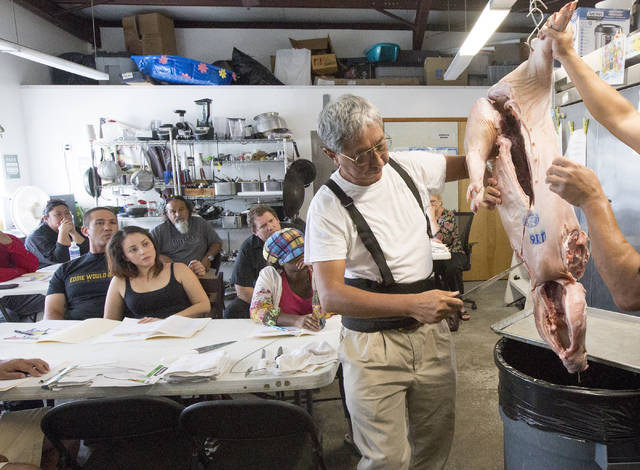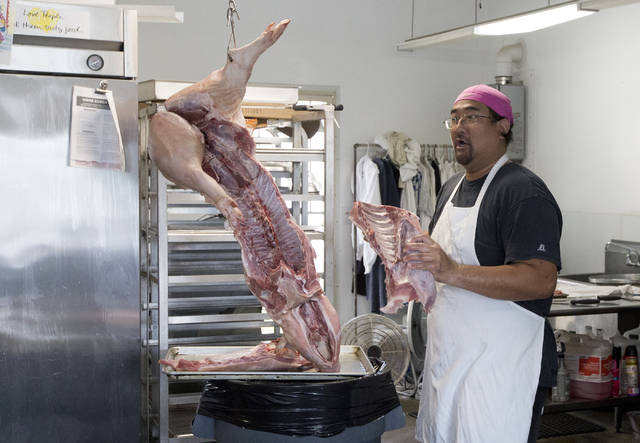Most pigs brought to a butcher weigh more than 300 pounds. ADVERTISING Most pigs brought to a butcher weigh more than 300 pounds. For beginning butchers, a beginner-size pig will do. On Saturday afternoon, nine men and five women watched
Most pigs brought to a butcher weigh more than 300 pounds.
For beginning butchers, a beginner-size pig will do.
On Saturday afternoon, nine men and five women watched as chef Dean Shigeoka pointed out the four major American butcher cuts, using a slaughtered and cleaned 66-pound pig hanging from a chain at The Kitchen, a commercial kitchen Shigeoka co-founded that is now used by a host of different businesses and organizations.
Volunteers approached the pig to begin carving off different cuts, until only a single shank was left hanging.
Over the next three hours, the pig would be turned into manapuas, bolognese sauce, Chinese lap cheong sausages and, of course, pork chops. Even the head was used, to create a porchetta di testa.
“It’s pretty yummy, actually,” Shigeoka said of the porchetta. That dish, along with the two chops, wouldn’t be ready until the following class in two weeks. It needed time to marinate in a flavorful blend of juniper and rosemary.
The pork chops needed time to cure. Students rubbed a coarse mixture of sodium nitrate and sodium nitrite across the meat cuts, which would over time break down the proteins in the muscle and make it more flavorful.
The butcher class is offered by the University of Hawaii at Hilo’s College of Continuing Education and Community Service. It’s part of a broader CCECS effort to increase food and food safety education.
Luisa Castro, agriculture food safety program manager for the Hawaii Department of Agriculture, started the classes two years ago when she was CCECS program coordinator. They also include a Master Food Preserver certificate program.
“It was definitely the right time,” Castro said. “It was after (Tropical Storm) Iselle and the lava flow cutting Puna off, and I was really thinking about what it was we could do to get people to prepare. … My background is actually in food safety, so it kind of all jelled together, pun intended, to teach about food preservation.”
The first classes were funded through a grant from the state Department of Labor and Industrial Relations. Castro said an anonymous donor also has helped subsidize the program. Those donations are coming to an end, so she applied for a U.S. Department of Agriculture grant to keep costs low for participants. That grant would fund classes for another three years.
“Normally, you look at a mainland (Master Preserver) course, and it’s usually $600,” Castro said. “Ours is $200.”
The butchery class is $80 for two three-hour-long classes. They are held two weeks apart, in order to give meats prepared during the first day time to cure and age.
“Definitely, a lot of people want to leave this class master butchers,” Shigeoka said. “But there are only two days, so we try to hit the basics. Most people just really want to learn more.”
Some in Saturday’s class were there for a simple reason: They liked to eat. Others wanted to learn a new skill, and many wanted to apply it directly to their own lives.
Russell Kokubun, a former state lawmaker, has raised sheep for a little more than a year. He’d read books about butchery before, but it wasn’t the same as getting hands-on experience.
“I think the more you learn, the more it opens the door,” he said. “You can see there’s so much excitement here, so much enthusiasm. I think it goes back to people wanting to know more about their food.”
Adrienne Hew knows her food — she’s a nutritionist and cookbook author — but decided to take the class in preparation for a cooking show she would be participating in during a conference in Vietnam later this month. The two-week follow-up class, where the porcetta di testa and pork chops would be unveiled, was the day before she left for her trip.
“I figured as much knowledge as I could get in would be helpful,” Hew said.
Current CCECS program coordinator Marisa Miyashiro said the food classes were some of the most popular offerings each semester.
Castro said she’s taught everyone from Department of Education teachers to chefs to homesteaders and farmers trying to learn about value-added products.
“I’ve been also really mindful of this as a good opportunity to be helping people along, the small farmers who maybe need to add to their incomes,” she said.
Such was the case with Carol Morse, who raises free-range organic chickens and hopes to add chicken sausage to her product line. Morse said she’d also signed up to learn the different curing methods.
“We’re planning to do lamb eventually,” she said.
Email Ivy Ashe at iashe@hawaiitribune-herald.com.




